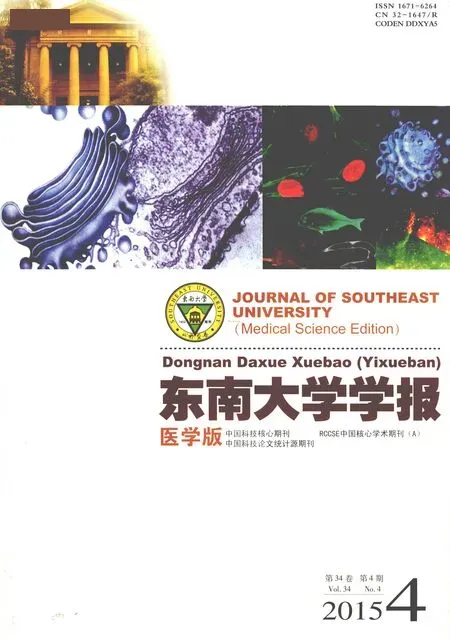Cav-1在胰腺癌中表达及与临床预后关系的研究
2015-03-24单涛郑波陈熹吴涛白育花季尔丽王继欣
单涛,郑波,陈熹,吴涛,白育花,季尔丽,王继欣
(西安交通大学医学院第二附属医院 普通外科,陕西 西安 710004)
·论 著·
Cav-1在胰腺癌中表达及与临床预后关系的研究
单涛,郑波,陈熹,吴涛,白育花,季尔丽,王继欣
(西安交通大学医学院第二附属医院 普通外科,陕西 西安 710004)
目的:肿瘤的发生发展不仅与肿瘤细胞的增殖有关,还依赖于肿瘤细胞和间质微环境之间的相互作用,对肿瘤微环境起关键调节作用的间质小窝蛋白-1(Cav-1)可能是一个潜在的治疗靶点,本研究旨在探讨胰腺癌间质Cav-1的表达能否作为客观的预后标志物。方法:选取45例胰腺癌标本,应用免疫组化法测定胰腺癌、癌旁及正常组织间质Cav-1表达,分析间质Cav-1的表达与临床病理特征和预后的相关性。结果:6例(13.3%)标本间质Cav-1呈强染色,8例(17.8%)呈低-中度染色,31例(68.9%)无染色。间质Cav-1表达缺失与TNM分期(P=0.018)、淋巴结转移(P=0.014)、远处转移(P=0.027)相关,与年龄、性别、组织学分级和肿瘤大小无显著性相关(P>0.05)。结论:胰腺癌间质Cav-1是独立预后指标,可作为胰腺癌有效治疗的靶标。
胰腺癌; 小窝蛋白-1; 预后; 免疫组织化学
胰腺癌是恶性程度较高的肿瘤之一[1]。研究表明,肿瘤微环境在肿瘤进展中起重要作用,突出了间质细胞在抗癌治疗中的重要性[2-4]。为了更充分地了解微环境在驱动肿瘤复发、转移以及决定临床预后的效用,发现新的微环境靶点非常重要。
小窝蛋白(Cav)是覆盖于50 nm至100 nm内陷细胞膜的一类骨架蛋白层[5],Cav家族包含3个亚型:Cav-1、Cav-2、Cav-3。Cav-1基因位于7号染色体(7q31.1),包括3个外显子(30、165、342 bp)和两个内含子(1.5、32 kb)。Cav-1蛋白参与多种细胞功能,如囊泡运输、胆固醇代谢和信号转导[6]。尽管越来越多的证据表明Cav-1与肿瘤发生相关,但是作为抑癌基因还是癌基因仍不清楚[7-9]。最近提出肿瘤代谢的自噬间质模型有助于对肿瘤微环境作用的理解[10-11],在这个模型中Cav-1是潜在的关键靶点[12]。研究显示间质Cav-1的表达缺失是早期乳腺癌复发和进展的唯一独立预测因素[7]。Ayala等报道称,间质Cav-1表达缺失通过参与Akt的活化使TGF-β1和SNCG表达上调而导致前列腺癌细胞的转移[13]。有报道称癌相关成纤维细胞中Cav-1的表达水平可预测胃癌预后;而在恶性黑色素瘤转移灶中间质Cav-1表达缺失预示着不良预后[14-15]。然而,胰腺癌中间质Cav-1的表达水平和临床意义尚不清楚。为了探讨胰腺癌Cav-1表达的意义,我们检测其在胰腺癌间质中的表达水平,以便分析Cav-1的表达与胰腺癌临床病理特征及预后的关系。
1 材料与方法
1.1 材料
选取2007年1月至2012年12月于西安交通大学第二附属医院肝胆胰外科进行胰十二指肠切除术(惠普尔术)的45例胰腺癌标本,10%福尔马林固定,正常胰腺组织作为对照。45例患者中,男24例,女21例,手术时平均年龄为64.5岁(44~82岁)。根据国际抗癌联盟的分类进行肿瘤分期和组织学分级的记录,其中Ⅰ期3例、Ⅱ期11例、Ⅲ期27例、Ⅳ期4例,组织学分级Ⅰ级7例、Ⅱ级20例、Ⅲ级18例。随访中位时间为22个月(4~52个月),标本获得均经本人或近亲同意并签署书面知情同意书,本研究经西安交通大学的机构审查委员会和伦理委员会批准。
1.2 免疫组化检测Cav-1蛋白
采用标准的SP法检测Cav-1蛋白。组织切片经处理后与一抗孵育过夜,继而与生物素标记的羊抗兔IgG孵育30 min,随后与过氧化物酶标记的链霉亲和素室温孵育20 min。在含0.02% 3,9-二氨基联苯胺的Tris-HCl溶液(pH 7.6)中染色5~7 min,最后经苏木精复染、水冲洗、脱水、清除、封片,用显微镜观察。染色半定量评分为:阴性(0分,不着色)、弱阳性(1分,弥漫弱阳性或强阳性间质细胞数<30%)以及强阳性(2分,染色强阳性细胞数≥30%)。抗Cav-1 和β-actin均购自Abcam(Cambridge, USA或Santa Cruz, USA)。
1.3 统计学处理
采用χ2检验或双面Fisher精确检验分析方法。Pearson相关系数用来衡量Cav-1关联强度。采用Kaplan-meier计算生存率、log-rank检验进行差异性检验。选择有显著性的因素逐步建立Cox多元比例风险模型,以确定其预后价值。P<0.05为差异有统计学意义。所有的统计学分析采用SPSS 13(SPSS,Chicago)软件。
2 结 果
2.1 胰腺癌间质中Cav-1的表达
Cav-1在细胞膜和胞质中均有表达[16],为了评估胰腺癌间质中Cav-1的表达状态,对胰腺癌、癌旁及正常组织均进行免疫组化检测。结果显示:Cav-1强表达几乎仅表达于癌旁及正常组织间质,在肿瘤组织间质仅偶尔检测到。45例肿瘤标本中,6例(13.3%)间质Cav-1呈强染色、8例(17.8%)呈低度染色、31例(68.9%)不着色(图1)。
N.正常胰腺组织; P.癌旁组织; C.胰腺癌组织
图1 免疫组化检测胰腺癌、癌旁、正常组织间质中Cav-1表达水平 ×400
N.Normal tissue strongly positive for Cav-1 expression; P.Paracancer tissue moderate for Cav-1 expression; C. Tumor tissue with negative Cav-1 expression
Fig 1 Representative immunohistochemistry results of stromal Cav-1 expression in pancreatic tissue(×400)
2.2 间质Cav-1表达缺失与临床病理参数的关系
表1总结了胰腺癌间质中Cav-1蛋白的表达与临床病理参数的联系。Ⅰ、Ⅱ期的14例中6例(42.9%)间质Cav-1表达缺失,显著低于Ⅲ期(77.8%,21/27)和Ⅳ期(100%,4/4)(P=0.018)。间质Cav-1的表达缺失与淋巴结转移(P=0.014)、远处转移(P=0.027)相关,与年龄、性别、组织学分级和肿瘤大小无显著相关性(P>0.05)。
2.3 间质Cav-1表达缺失与胰腺癌预后相关性
为明确胰腺癌间质Cav-1缺失的预后价值,对Cav-1不同表达状态的患者累积生存率进行分析(图2),间质Cav-1表达缺失,即无染色,定为阴性,弱染色或强染色定为阳性。间质Cav-1阴性患者(n=31)3年累积生存率为8.8%(中位时间16个月),相反地,Cav-1阳性患者(n=14)的累积生存率为20.2%(中位时间28个月),差异有统计学意义(P<0.05)。
多因素分析显示,淋巴结转移和TNM分期是胰腺癌患者总生存期的独立预后因素,间质Cav-1蛋白的表达缺失也是总生存期的独立预后因素(P=0.006),然而肿瘤大小等临床参数不是独立的预后因素。
3 讨 论
实体肿瘤进展除细胞内在特性外,还得益于肿瘤周围丰富的炎症细胞和间质细胞交互作用[17],暗示肿瘤的治疗应同时针对肿瘤细胞及间质细胞[18]。肿瘤代谢自噬间质模型[19]表明作为关键调节剂的间质Cav-1表达缺失是潜在的治疗靶向,且进一步表明间质细胞Cav-1的表达可能具有预测预后价值。此外,间质Cav-1表达缺失已证实是乳腺癌早期复发、淋巴结转移、他莫昔芬耐药和不良临床预后的预测因子[20]。本研究结果显示与癌旁和正常组织相比,间质Cav-1在胰腺癌中表达下调,其表达缺失与高TNM分期、淋巴结转移、远处转移和不良预后相关。本研究首次表明间质Cav-1的表达缺失是胰腺癌的不良预后指标。然而,Witkiewicz等[21]的研究表明,FASN和Cav-1的共表达可能是有价值的临床指标,他们发现Cav-1和FASN在胰腺低分化腺癌中表达高于胰腺导管上皮内瘤变中的水平。除肿瘤上皮细胞外Cav-1也存在于肿瘤相关成纤维细胞中,间质Cav-1在正常胰腺或邻近肿瘤细胞的慢性胰腺炎组织中为阴性,这与本研究结果不一致。这种差异可能归因于Witkiewicz等研究中两分子(FASN和Cav-1)免疫定位中的互相干扰,而且,研究中的Cav-1抗体特异性有差异。最后,标本的异质性可能也会影响结果。鉴于Witkiewicz等的研究结果与本研究不一致,仍需进一步的探索。
Cav-1蛋白是细胞膜穴样内陷的结构蛋白,存在于大多数哺乳动物细胞中[22]。Cav-1蛋白是细胞小窝的主要结构蛋白,并被认为是参与细胞恶性转化和恶性进展的关键分子[23]。Cav-1在几条导致细胞转化的信号通路中起重要的调节作用,包括由Src家族酪氨酸激酶、表皮生长因子受体、HER-2/neu、C反应蛋白、Wnt信号和Erk1/2介导的信号转导[6,24-26]。根据肿瘤的类型和(或)分期,Cav-1被认为是抑癌基因或癌基因。这两种不同的作用可能是因为Cav-1不同结构域的不同激活状态影响,或是由信号通路中与Cav-1蛋白相互作用的分子的表达所致[27]。最近,有几项研究对Cav-1蛋白在肿瘤进展中的潜在作用进行了评估[8,28-30],然而,Cav-1的表达与肿瘤进展之间的关系在细胞和分子水平仍不清楚。基于肿瘤代谢自噬间质模型,Cav-1蛋白表达缺失可能通过代谢转化机制而影响肿瘤进展,这值得进一步的研究。
表1 胰腺癌间质Cav-1表达与临床病理因素关系 例
Tab 1 Association between stromal Cav-1 expression and clinicopathologic factors in pancreatic cancers cases
aP<0.05
注:括号中为所占百分比
总之,间质Cav-1蛋白在胰腺癌中表达下调,且与高TNM分期、淋巴结转移和不良预后紧密相关,因此,间质Cav-1可作为胰腺癌侵袭性的新的生物标志物。
[1] GOBBI P G,BERGONZI M,COMELLY M,et al.The prognostic role of time to diagnosis and presenting symptoms in patients with pancreatic cancer[J].Cancer Epidemiol,2013,37(2):186-190.
[2] KOONTONGKAEW S.The tumor microenvironment contribution to development,growth,invasion and metastasis of head and neck squamous cell carcinomas[J].J Cancer,2013,4(1):66-83.
[3] SHARON Y,ALON L,GLANZ S,et al.Isolation of normal and cancer-associated fibroblasts from fresh tissues by fluorescence activated cell sorting (FACS)[J].JoVE,2013(71):e4425.
[4] CIRRI P,CHIARUGI P.Cancer-associated-fibroblasts and tumor cells:a diabolic liaison driving cancer progression[J].Cancer Metast Rev,2012,31(1-2):195-208.
图2 胰腺癌间质Cav-1表达阳性和阴性患者生存曲线图
Fig 2 Kaplan-Meier analysis of the overall postoperative survival curves in patients with pancreatic cancer according to immunohistochemical staining as positive or negative of stromal Cav-1 expression
[5] SONG Y,XUE L L,DU S,et al.Caveolin-1 knockdown is associated with the metastasis and proliferation of human lung cancer cell line NCI-H460[J].Biomed Pharmacother,2012,66(6):439-447.
[6] HA T,HER N,LEE M,et al.Caveolin-1 increases aerobic glycolysis in colorectal cancers by stimulating HMGA1-mediated GLUT3 transcription[J].Cancer Res,2012,72(16):4097-4109.
[7] SIMPKINS S A,HANBY A M,HOLLIDAY D L,et al.Clinical and functional significance of loss of caveolin-1 expression in breast cancer-associated fibroblasts[J].J Pathol,2012,227(4):490-498.
[8] 杨晓寒,熊海,关珠珠,等.Caveolin-1高表达抑制人小细胞肺癌(SCLC)细胞凋亡[J].中国癌症研究,2012,30(6):453-462.
[9] TANG Y,ZENG X T,HE F,et al.Caveolin-1 is related to invasion,survival,and poor prognosis in hepatocellular cancer[J].Med Oncol,2012,29(2):977-984.
[10] ZHENG J.Energy metabolism of cancer:glycolysis versus oxidative phosphorylation(Review)[J].Oncol Lett,2012,4(6):1151-1157.
[11] PAVLIDES S,VERA I,GANDARA R,et al.Warburg meets autophagy:cancer-associated fibroblasts accelerate tumor growth and metastasis via oxidative stress,mitophagy,and aerobic glycolysis[J].Antioxid Redox Signal,2012,16(11):1264-1284.
[12] BONUCCELLI G,WHITAKER-MENEZES D,CASTELLO-CROS R,et al.The reverse warburg effect glycolysis inhibitors prevent the tumor promoting effects of caveolin-1 deficient cancer associated fibroblasts[J].Cell Cycle,2010,9(10):1960-1971.
[13] AYALA G,MORELLO M,FROLOV A,et al.Loss of caveolin-1 in prostate cancer stroma correlates with reduced relapse-free survival and is functionally relevant to tumour progression[J].J Pathol,2013,231(1):77-87.
[14] ZHAO X D,HE Y Y,GAO J,et al.Caveolin-1 expression level in cancer associated fibroblasts predicts outcome in gastric cancer[J].PLoS One,2013,8 (3):e59102.
[15] WU K N,QUEENAN M,BRODY J R,et al.Loss of stromal caveolin-1 expression in malignant melanoma metastases predicts poor survival[J].Cell Cycle,2013,10(24):4250-4255.
[16] TAHIR S A,PARK S,THOMPSON T C.Caveolin-1 regulates VEGF-stimulated angiogenic activities in prostate cancer and endothelial cells[J].Cancer Biol Ther,2009,8(23):2286-2296.
[17] MAO Y,KELLER E T,GARFIELD D H,et al.Stromal cells in tumor microenvironment and breast cancer[J].Cancer Metast Rev,2013,32(2):305-315.
[18] BALKWILL F R,CAPASSO M,HAGEMANN T.The tumor microenvironment at a glance[J].J Cell Sci,2012,125(23):5591-5596.
[19] PAVLIDES S,WHITAKER-MENEZES D,CASTELLO-CROS R,et al.The reverse warburg effect:aerobic glycolysis in cancer associated fibroblasts and the tumor stroma[J].Cell Cycle,2009,8(23):3984-4001.
[20] WITKIEWICZ A K,DASGUPTA A,SAMMONS S,et al.Loss of stromal caveolin-1 expression predicts poor clinical outcome in triple negative and basal-like breast cancers[J].Cancer Biol Ther,2010,10(2):135-143.
[21] WITKIEWICZ A K,NGUYEN K H,DASGUPTA A,et al.Co-expression of fatty acid synthase and caveolin-1 in pancreatic ductal adenocarcinoma:implications for tumor progression and clinical outcome[J].Cell Cycle,2008,7(19):3021-3025.
[22] TRIMMER C,SOTGIA F,WHITAKER-MENEZES D,et al.Caveolin-1 and mitochondrial SOD2 (MnSOD) function as tumor suppressors in the stromal microenvironment a new genetically tractable model for human cancer associated fibroblasts[J].Cancer Biol Ther,2011,11(4):383-394.
[23] PATANI N,MARTIN L,REIS-FILHO J S,et al.The role of caveolin-1 in human breast cancer[J].Breast Cancer Res Tr,2012,131(1):1-15.
[24] PANCOTTI F,RONCUZZI L,MAGGIOLINI M,et al.Caveolin-1 silencing arrests the proliferation of metastatic lung cancer cells through the inhibition of STAT3 signaling[J].Cell Signal,2012,24(7):1390-1397.
[25] SUN M,GUAN Z,LIU S,et al.Caveolin-1 interferes cell growth of lung cancer NCI-H446 cell through the interactions with phosphoERK1/2,estrogen receptor and progestin receptor[J].Biomed Pharmacother,2012,66(4):242-248.
[26] SALANI B,MAFFIOLI S,HAMOUDANE M,et al.Caveolin-1 is essential for metformin inhibitory effect on IGF1 action in non-small-cell lung cancer cells[J].FASEB J,2012,26(2):788-798.
[27] DU X,QIAN X,PAPAGEORGE A,et al.Functional interaction of tumor suppressor dlc1 and caveolin-1 in cancer cells[J].Cancer Res,2012,72(17):4405-4416.
[28] GUMULEC J,SOCHOR J,HLAVNA M,et al.Caveolin-1 as a potential high-risk prostate cancer biomarker[J].Oncol Rep,2012,27(3):831-841.
[29] SOTGIA F,MARTINEZ-OUTSCHOORN U E,HOWELL A,et al.Caveolin-1 and cancer metabolism in the tumor microenvironment:markers,models,and mechanisms[J].Annu Rev Pathol,2012,7:423-467.
[30] 林传彬,张才全,吴帅.Caveolin-1在结肠癌中的表达及其与结肠癌发生发展的关系[J].中国现代医学杂志,2011,21(14):1600-1602.
Loss of stromal caveolin-1 expression:a novel tumor microenvironmentbiomarker that can predict poor clinical outcomes for pancreatic cancer
SHAN Tao,ZHENG Bo,CHEN Xi,WU Tao,BAI Yu-hua,JI Er-li,WANG Ji-xin
(DepartmentofGeneralSurgery,theSecondAffiliatedHospitalofMedicalCollege,Xi’anJiaotongUniversity,Xi’an710004,China)
Objective: Cancer development and progression is not only associated with the tumor cell proliferation but also depends on the interaction between tumor cells and the stromal microenvironment. A new understanding of the role of the tumor microenvironment suggests that the loss of stromal caveolin-1 (Cav-1) as a key regulator may become a potential therapy target. This study aims to elucidate whether stromal Cav-1 expression in pancreatic cancer can be a strong prognosis biomarker. Methods: Tissue samples from 45 pancreatic cancer patients were studied. Stromal Cav-1 expression was measured from pancreatic cancer, paraneoplastic, and normal tissue by using immunohistochemistry. We analyzed the correlation of stromal Cav-1 expression with clinicopathologic features and prognostic. Results: Specimens from six patients(13.3%) showed high levels of stromal Cav-1 staining, those from eight patients(17.8%) showed a lower, intermediate level of staining, whereas those from 31 patients (68.9%) showed an absence of staining. Stromal Cav-1 loss was associated with TNM stage(P=0.018), lymph node metastasis(P= 0.014), distant metastasis(P= 0.027). The relationships of age, sex, histological grade, and tumor size with stromal Cav-1 expression were not significant(P>0.05). Conclusion: The loss of stromal Cav-1 in pancreatic cancer is an independent prognostic indicator, thus suggesting that stromal Cav-1 may be an effective therapeutic target for patients with pancreatic cancer.
pancreatic cancer; caveolin-1; prognosis; immunohistochemistry
2015-03-04
2015-04-12
国家自然科学基金资助项目(81402583); 陕西省自然科学基金资助项目(2014JQ4165); 西安交通大学校基金资助项目(xjj2014077)
陈熹 E-mail:Chenxi@163.com
单涛,郑波,陈熹,等.Cav-1在胰腺癌中表达及与临床预后关系的研究[J].东南大学学报:医学版,2015,34(4):552-557.
R735.9
A
1671-6264(2015)04-0552-06
10.3969/j.issn.1671-6264.2015.04.012
